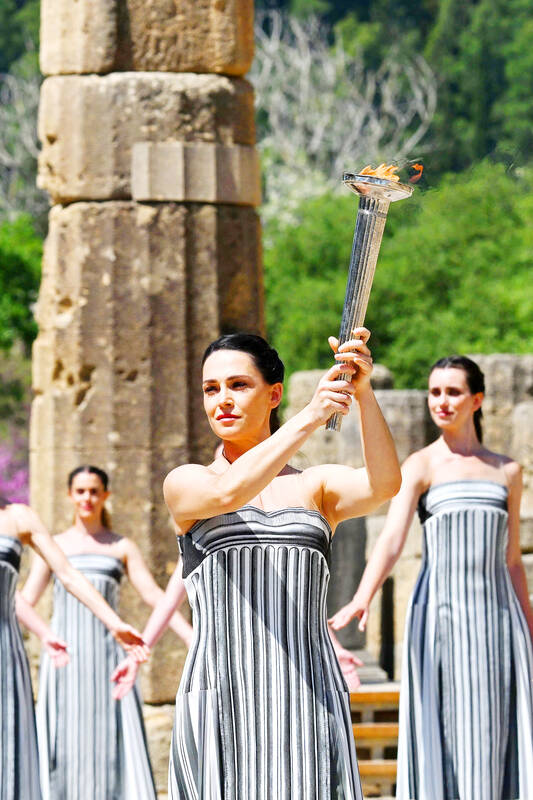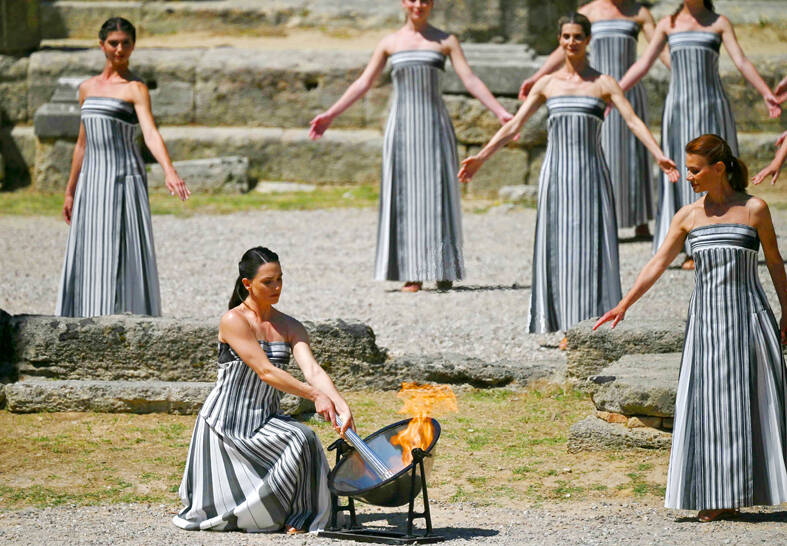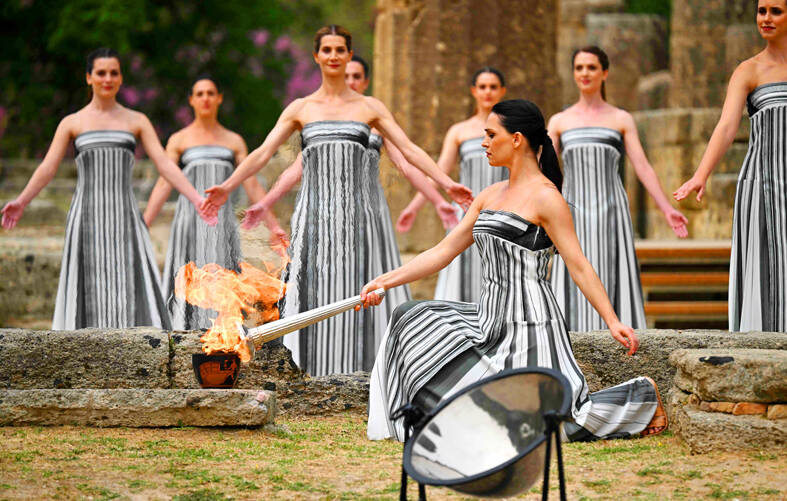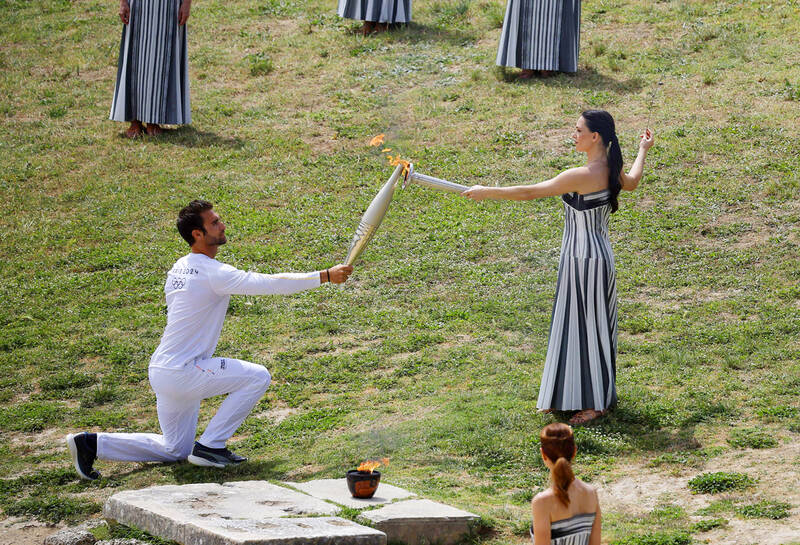On Tuesday last week, the flame for this summer’s Paris Olympics was lit at the birthplace of the ancient Olympic Games in southern Greece in a meticulously choreographed ceremony.
It will then be carried through Greece for more than 5,000km before being handed over to French organizers at the Athens venue used for the first modern Olympics in 1896.
The pageantry at Olympia has been an essential part of every Olympics for nearly 90 years since the Games in Berlin. It’s meant to provide an ineluctable link between the modern event and the ancient Greek original on which it was initially modelled.

Photo: AFP 照片:法新社
Once it’s been carried by any means imaginable to the host city — it has been beamed down by satellite, lugged up Mount Everest and towed underwater — the flame kindles a cauldron that burns in the host Olympic stadium until the end of the games. Then it’s used for the Paralympics.
An actor playing an ancient Greek priestess holds a silver torch containing highly combustible materials over a concave mirror. The sun’s rays bounce off every inch of the burnished metal half-globe and come together at one extremely hot point, which ignites the torch.
This happens inside the archaeological site at Olympia, before the ancient temple of Hera — wife of Zeus, king of the Greek gods, whose own ruined temple lies close by.

Photo: AFP 照片:法新社
The flame is eventually used to light the first runner’s torch — champagne-colored this year for France — and a long relay through Greece leads to the April 26 handover at the Panathenaic stadium in Athens.
The idea was the result of Greek-German cooperation ahead of the 1936 Olympics in Nazi Germany, which were heavy on fanfare — and swastikas. It was based on a mechanism mentioned by ancient writers in a non-Olympic context, and served the desire to blend the games of antiquity with the modern revival.
The 1936 innovations included a torch relay all the way to Berlin, and have been followed, with modifications, ever since. An initial idea to do the relay flame in hollow plant stalks — a nod to the Greek myth of Prometheus who stole fire from the gods — was ditched as impractical.

Photo: AFP 照片:法新社
According to ancient Greek tradition, the games of antiquity, held every four years in honor of Zeus, started in 776 BC. They were the most important of the major Greek sporting festivals, where events included running, wrestling and horse racing. Up to 40,000 spectators could attend.
Like in most preindustrial societies, life in ancient Greece was deeply physical and a well-exercised body was seen as the mark of a gentleman.
The games continued, with minor blips, until the new Christian authorities in Greece banned them as part of the reprehensible pagan past, in A.D. 393.

Photo: Reuters 照片:路透
(AP)
今年夏天將舉行的巴黎奧運,其聖火上週二在古代奧運會的發源地希臘南部,透過精心編排的儀式點燃。
聖火將穿越希臘五千多公里,然後在舉辦1896年第一屆現代奧運的雅典場館移交給法國代表。
自柏林奧運起近九十年來,奧林匹亞的盛典都是每屆奧運的重要部分,其目的是將現代奧運及其所本的古希臘奧運緊密連結起來。
聖火一傳遞到主辦城市,透過任何可想像的方式——曾以衛星發射光柱傳遞、被帶上聖母峰,還曾經過水下——聖火就會點燃奧運主場內的聖火台,繼續燃燒至奧運會結束,之後用於帕拉林匹克運動會(帕運會)。
扮演古希臘女祭司的演員,手持裝有高度易燃材料的銀色火炬,移至凹面鏡上方。陽光由這拋光金屬半球的每一部分反射出來,匯聚到一個極熱的點,將火炬點燃。
該儀式在奧林匹亞考古遺址舉行,位於古希臘眾神之王宙斯之妻赫拉的神殿前,赫拉神殿的廢墟就在附近。
這火焰最後用來點燃第一位聖火傳遞者的火炬——今年巴黎奧運的火炬顏色為香檳色——然後在希臘進行長途傳遞,4月26日將在雅典帕納辛納克體育場交接。
此做法是希臘及納粹德國合作舉辦1936年奧運的產物,當時大張旗鼓,會場充斥納粹黨徽。它所依據的是古代作家所提到的一種機制(但其脈絡並非在談論奧運),目的是將古代運動及其現代復興融合在一起。
1936年的創新包括將火炬一路傳遞到柏林,此後一直沿襲並加以修改。最初的構想是以空心的植物莖傳遞火焰——這是為了致敬希臘神話中向眾神偷火的普羅米修斯——但由於執行困難而作罷。
根據古希臘傳統,古代運動會每四年舉行一次以紀念宙斯,始於西元前776年。這是希臘最重要的體育節慶,活動包括跑步、摔角和賽馬。最多可容納四萬名觀眾。
與大多數前工業社會一樣,古希臘非常注重身體素質,鍛鍊良好的身體被視為高貴人士的標誌。
古代運動會繼續舉辦,雖然有些小問題,直到西元393年,希臘新的基督教當局將它視為應受譴責的異教傳統而禁止。
(台北時報林俐凱編譯)

A: When is the Lantern Festival? B: The festival is celebrated on the 15th day of the first month of the lunar calendar, which fell on Feb. 12 this year. A: Oh no! Did I miss the 2025 Taipei Lantern Festival? B: Yes, you did. But you can still go to the 2025 Taiwan Lantern Festival in Taoyuan, which will run until this Sunday. A: Let’s go admire the exuberant lanterns. A: 元宵節到底是哪一天? B: 就是農曆1月15日啊,今年則落在國曆2月12日。 A: 喔不,我是不是錯過了2025台北燈節? B: 是的,但你還可以去桃園的2025台灣燈會,活動將持續至週日。 A: 那我們去欣賞豐富的花燈秀吧! (By Eddy Chang, Taipei Times/台北時報張聖恩)

A: What’s the theme of the 2025 Taiwan Lantern Festival’s main lantern? B: The theme is “Paradise,” and the main lantern is a snake-shaped “infinity” symbol that features a lighting show every half an hour. A: Cool, I heard that there are over 300 lanterns. B: There are even giant lanterns in the shape of Pikachu and some other popular Pokemon characters. A: Let’s go now. A: 2025台灣燈會主燈的主題是什麼? B: 主題是「無限樂園」!主燈的造型則是蛇形的數學「無限號」,主燈每半小時還有一次燈光秀。 A: 酷喔,聽說總共有300多件花燈作品。 B: 甚至還有皮卡丘和其他熱門寶可夢角色的巨型花燈呢。 A: 哇我們現在就出發吧! (By Eddy Chang, Taipei Times/台北時報張聖恩)

本文由生成式AI協作,本刊編輯編修。 Tucked away in southwestern Taiwan, Yunlin County is a treasure trove of cultural heritage, rich history, and natural beauty. From its stunning temples and glove puppetry to historical architecture and picturesque landscapes, Yunlin rewards those who venture off the beaten path. Yunlin is renowned for its flourishing temple culture. Temples in this region are not merely places of worship but also communal centers where people gather for festivals, rituals, and social functions. One of the most notable temples here is the Beigang Chaotian Temple, which was built more than 300 years ago and is dedicated to Matsu, the sea

Nestled within the heart of Taipei, National Taiwan University (NTU) contains a grand and spacious sanctuary where nature and academia come together in perfect accord. Across its expansive 111-hectare campus, NTU reveals a landscape rich with history, lush greenery, and a thoughtfully preserved ecosystem. This tranquil haven invites visitors to take their time wandering among the elegant buildings, to admire the rare plants, and to experience a space that exudes quiet inspiration. Zhoushan Road: A Gentle Prelude to NTU’s Tranquility Beginning at Gongguan MRT Station, the enchanting avenue Zhoushan Road leads visitors into NTU shaded by golden rain trees, cottonwoods, and Javanese